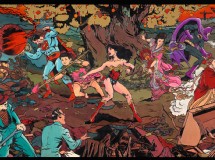- Eliminate the need for tricky batting by using polar fleece.
Use the fabric as your entire quilt top. This may be ideal for a child. If the quilt needs to be made larger, use a sewing machine to attach long rectangles of fabric down the sides or across the bottom and top to reach your desired measurements. Cut a piece of fabric of the same measurements as the quilt top to use as backing.
Pin a layer of batting, insulating material usually sold in long strips in craft stores, between the top and bottom layers of your quilt. This makes a "sandwich" out of the three layers, with the batting in the middle. Sew around the edges of the quilt, securing the batting between the two layers, but being careful not to allow any of the batting or raw edges to show on the outside of the quilt.
An easy alternative for an absolute beginner would be to use a piece of polar fleece as the backing, eliminating any need for a layer of batting and producing a lightweight but incredibly warm quilt.
Thread a tapestry needle with yarn or fabric scraps of your choice, coordinating with the colors of the panels. Knot one end of the yarn or fabric scrap, leaving a long tail. Pull the needle threaded with yarn or fabric scraps through the backing, batting, and book panel fabric. Push the needle down through the layers of fabric again. Cut the yarn or scrap and knot it to your first long tail. Leave these hanging, or trim them so they are shorter. You may also choose to reverse the process and have the knotted tails at the front of your work, poking out of the corners of the book panels. Repeat this process for each square of each panel. While it is tedious work, you will end up with cherished item that will get much use from the recipient. - Use the book panel fabric as part of a larger project by making individual blocks out of the squares.
Carefully cut away each book panel and use it as part of a larger quilt block or square. Sew strips of fabric or tiny squares around each panel, then reassemble the embellished book panels to show the story again. Attach a layer of batting and a layer of backing fabric. Sew through the three layers of fabric around each book panel, which will create a dent in the blanket, and make the panels stand out from the rest of the square. - Photocopy unique or unusual books or book pages and make your own book panel quilt.
Make color photographs of your favorite passages or scenes from a book. For adults, this may be text only pages. Use a solid-color top for the quilt. Sew pockets of clear vinyl, large enough to accommodate your pages, to the fabric. Leave one end of the pocket open, and slide your pages in. Add batting and a backing, and be sure to remove the book pages before laundering your homemade book panel quilt.
Beginner's Book Panel Quilt
Intermediate-to-Advanced Quilting With Book Panels
Make Your Own Book Panels
SHARE







































